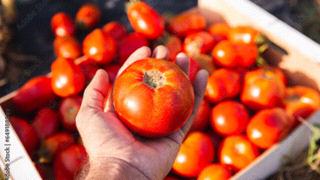Everyone loves tomatoes. Of all the vegetables, the tomato plant is grown by more people. This past summer was an especially hard year for gardeners and tomatoes. We had a cold spring and tomatoes like warmth so they sit in the ground and won’t grow. Then came the hot summer and tomatoes won’t set on fruit when temperatures are over 95 degrees. Finally, in September we had perfect weather and we had our tomatoes, just before the October freezes killed them.
Gardeners are not deterred. My seed catalogs start arriving in November. (There was a time when they were sent out after the New Year but like everything else, the date keeps getting earlier.) If you aren’t included in mailing lists for seed catalogs, don’t despair. There is now the internet. You can type “tomato seeds” or catalog names such as: Johnny’s Seeds, Seeds N Such, and Totally Tomatoes and you will have access to the world of tomato growing. Even if you don’t want to grow your tomatoes from seed, seeing all of the varieties available is an eye-opener. If you want to buy your tomatoes already started but want more of a selection than available from the big box stores, check out local nurseries or the farmer’s market. You will find tomatoes that do best in our climate because they are grown here.
The date to maturity is very important because it determines and you will have access to the world of tomato growing: when you will pick your first tomato. We have a short growing season in the High Desert so it is important to look for early maturity dates or you will be picking your first tomato when we get our first frost. There are some tomatoes that mature in 48 days and others take as long as 90 to 100 days. The maturity date starts when the plant is put in the ground. If you buy a tomato plant with fruit already growing, that tomatoes will mature but you will get no more tomatoes for the next four to six weeks.
The second thing to consider is the growing style of the tomato: indeterminate or determinate. The indeterminate tomatoes are sometime called vining types because they will grow 6 to 10+ feet in a few months. This was the original tomato and is how many common tomatoes grow. The plant will continue to grow and produce tomatoes along its many branches until killed by frost. You will have to decide how to deal with the long vines. You can either put them in cages or let them crawl across the ground. Ground is easier but if you do that, you will have some loss from rot and slugs. Determinate tomatoes are also called bush or patio tomatoes because they will grow well in a container or hanging basket. These tomatoes produce over two months (which is most of our tomato producing season) and were originally used for production of sauces and ketchup. Now they are preferred by people who love tomatoes but don’t have the space for a full garden.
Size of tomato is another consideration. Everyone is interested in the extra-large tomatoes. The Beefsteak tomatoes you may have grown in other areas of the country are not suited to the High Desert. They need 80 to 100 days of warm soil with day temperatures in the 80s and night temperatures in the 70s. We have the heat during the day but our nights are cool to cold and the tomatoes rebel. There are tomatoes that are not as large and have been bred to thrive in cool evening temperatures. The tomatoes that have a short maturing date will have a note that indicates they are suitable for cooler areas of the country.
Disease resistance may be important to you if you have grown tomatoes in your garden and suddenly have had your tomatoes die or just quit producing. If it isn’t caterpillars or bugs then it is likely one of many diseases that can affect tomatoes. Hybrid tomatoes were developed to grow even where there have been problems with fungi. Hybrid tomatoes are a cross of two different tomatoes and are not genetically modified. The names of the various fungi are given an abbreviation and they are listed next to the name of the tomato. On Early Girl Hybrid VFF stands for Verticillium Wilt and Fusarium Wilt Races 1 & 2. The more letters, the more disease resistance.
Another category not often listed but useful to know is “Not suitable for shipping”. Usually this is a thin-skinned tomato or one that needs to be ripe when it is shipped. These are often the best tasting tomatoes and worth a more detailed look. The best example is the cherry tomato. The ones shipped to grocery stores are bred for a tough skin for shipping and have sacrificed taste. Compare that to the full tomato taste of Sun Gold or the sweetness of Sweet 100 and you will be a convert.
One more type of tomato is the meaty, paste type used to make ketchup or sauces. Originally, they were all determinant but now they can be the vining, long producing indeterminant. The most famous one is the Roma tomato.
There is so much to say about our love of tomatoes and its place in our gardens. As time approaches for planting next year, look for an article from another Master Gardener, Natalia Varezkina-Elliott.
Edith Iwan is a Cibola- McKinley County Master Gardener who lives and works in Thoreau. As a Master Gardener she assists the County Cooperative Extension Service in providing accurate, research-based gardening information to county residents. If you have any gardening questions, please call the NMSU Cibola County Extension at 505-287-9266 or NMSU McKinley County Extension at 505-863-3432

